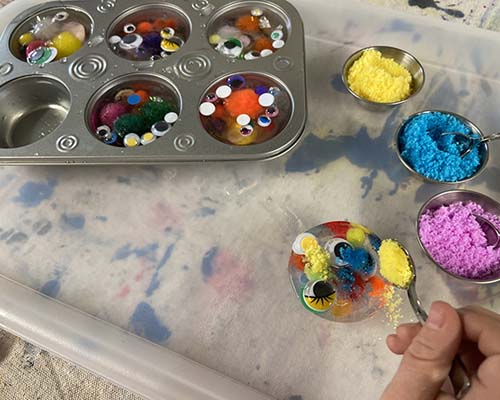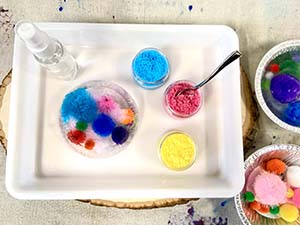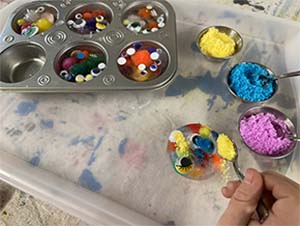Frozen Loose Parts Treasures

Explore the scientific properties of freezing and melting with
this fun and colorful activity using a variety of “loose parts”!
What are loose parts? Loose parts are open-ended and versatile materials that can be used in a variety of ways. They can be found, bought, taken out of your recycling bin, or even taken from other art projects and repurposed. With loose parts children can use their imaginations to create in endless ways. Some examples of loose parts can be found in our materials list below.
Explore the scientific properties of freezing and melting with this fun and colorful activity using a variety of “loose parts”!What are loose parts? Loose parts are open-ended and versatile materials that can be used in a variety of ways. They can be found, bought, taken out of your recycling bin, or even taken from other art projects and repurposed. With loose parts children can use their imaginations to create in endless ways. Some examples of loose parts can be found in our materials list below.
Ready, Set, Create!
![]() Place a variety of small loose parts into sections of muffin tins or ice cube trays. The larger the container, the more items can fit. If working with younger children, you can even freeze larger loose parts in Tupperware containers.
Place a variety of small loose parts into sections of muffin tins or ice cube trays. The larger the container, the more items can fit. If working with younger children, you can even freeze larger loose parts in Tupperware containers.
![]() Fill the containers with water and freeze overnight.
Fill the containers with water and freeze overnight.
![]() Fill spray bottles with water or provide small bowls with water and spoons.
Fill spray bottles with water or provide small bowls with water and spoons.
![]() Place the frozen blocks into a sensory table or on a tray.
Place the frozen blocks into a sensory table or on a tray.
![]() Encourage children to spoon or spray water onto the frozen items.
Encourage children to spoon or spray water onto the frozen items.

![]() Talk about what happens as the ice melts and the treasures are revealed.
Talk about what happens as the ice melts and the treasures are revealed.

Engage Children in Conversation
Comment on what you observe, such as “I notice you’re using your hands to squirt water on this cube of ice” or “What do you think will happen when the water hits the ice?”
Ask children open ended questions that encourage critical thinking, such as:
When you hold the ice in your hand do you think it will melt faster than when it’s in the sensory table? Why or why not?
Which method do you think will cause the ice to melt more quickly, spraying the ice or spooning water onto it? Why?
What happens when you pour salt onto the ice? Why do you think this happens?
Extensions
You could turn this into an “I Spy” activity by giving children photographs of the objects that have been frozen. Items can be checked off the list (like a green pom pom, red piece of craft stem, wiggle eye, etc.) as they melt and separate from the ice block.
This activity can also lead to conversations about melting and freezing. Caregivers can also set out small containers of salt for children to spoon or sprinkle onto the ice blocks. Predictions can be made about whether the ice will melt faster with the salt or just with water.
*To really spice things up, salt can be colored by putting it in a zip lock bag, adding liquid watercolors or food coloring, and shaking the bag until all the salt is colored.
Modifications
![]() If children are not able to use spray bottles, they can use spoons to dump water on the frozen blocks. They can also use smaller squirt bottles that may be easier to manipulate.
If children are not able to use spray bottles, they can use spoons to dump water on the frozen blocks. They can also use smaller squirt bottles that may be easier to manipulate.
